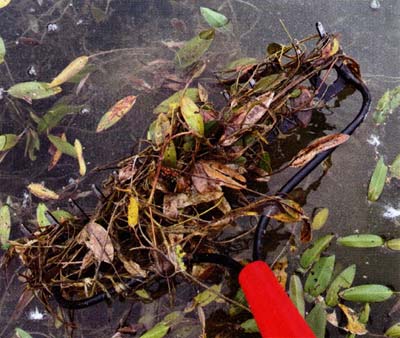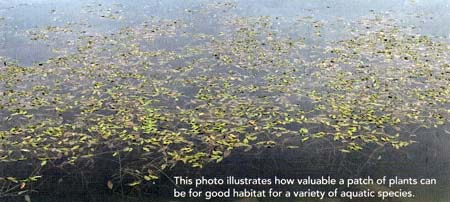
Terrestrial (land) plants come in all different shapes and sizes. Looking at plants in nature, there are small herbaceous plants like grasses and flowers, and towering trees with long, straight, strong trunks.
Aquatic (water) plants also come in different shapes and sizes or characteristics. Like terrestrial plants, the characteristics of aquatic plants are related to where the aquatic plant grows in a pond.
Emergent plants grow in shallow water along the shore. They have sturdy stems and grow tall out of the water, trying to outcompete their neighbors for sunlight. Submerged plants grow in deeper water and use the water to hold themselves up; the stems of submergent plants tend to be very bendy instead of rigid and sturdy. The plants that grow in even deeper water hardly grow tall because there isn't enough sunlight to support much growth. These plants cover the pond bottom and collect any light they can get, like moss on a forest floor.
Emergent plants include plants like cattails and rushes. They grow in wet areas with less than 3 feet of water. Emergent plants provide shelter and protection for all sorts of pond creatures, including baby fish, frogs, salamanders, bugs, other invertebrates, and birds, including places for bird nests, especially red-wing blackbirds. Emergent plants also help maintain the physical structure of the pond. The roots grow into the soil on the pond's edge and help keep it from eroding or washing away when there are waves and heavy rain.

Additionally, a healthy, vibrant, emergent plant area in a pond helps filter debris out of a pond. The emerging stems collect leaves and other stuff floating around or flowing into a pond in runoff (flowing extra rain) and keep it from clogging the rest of the pond. This collected dead material, called detritus, decays and creates rich, nutritious food for the plants and animals that grow in the emergent plant zone.
Submergent plants grow in water up to and sometimes deeper than three feet. Floating leaf plants are plants with long, flowy stems that reach from the bottom of the pond to the surface, like a boat's anchor rope, and the leaves float around the water's surface, gathering sunlight. Other submergent plants include coontail, milfoil, tapegrass, and waterweed. Unlike floating leaf plants, these plants have leaves that start closer to the pond bottom, and they create a sort of underwater forest that gently moves and sways with the water. This forest-like zone of submergent plants usually grows where a pond is 2-6 feet deep.
This area provides a safe place for smaller fish to hide from predators. The submergent plants turn sunlight into food using photosynthesis and, in return, release oxygen into the pond for animals to use. The submergent plant zone in a pond is rich with life!
The underwater forest gives way to Chara, Elodea, and Spikerush in deeper water. These plants are short and cover the pond bottom in a thick mat. They are short because there isn't enough sunlight in deep water for plants to create the energy to grow long stems. Water filters and reflects sunlight, so the plants in deep water must be very thrifty with their resources. These plants help stabilize (keep from moving) the bottom of the pond and provide homes for many invertebrates.

When a pond has many different kinds (species) of plants and various types of plants, it has a diversity of habitats for other living things in the pond. A pond with diverse plant habitats can provide homes to many insects, amphibians, and birds— especially fish.
The food web in a pond with diverse primary producers will be strong and large. This means that both bait fish and game fish can live and thrive in the pond, which will be vibrant with life for at least three seasons of the year. Ponds with greater diversity will be more able to survive severe weather events and other problems that might severely impact a less diverse pond. Now that you know that there are different types of water plants, why not take a closer look at them? A simple way to do that might be to go for a swim and grab some plants. But that's not always safe, possible, or the best choice. Maybe it's chilly, and you want to stay dry! Or swimming isn't safe for some reason! In that case, use a rake on a rope. Here's how:
- Explain the process to an adult and get permission and help as needed.
- Find a bow rake, garden rake, or similar.
- Tie some paracord (or other rope) to the end of the handle (this may require an adult to drill a hole).
- Throw the rake, tines down, at some submerged plants, and pull the rake back in.
- Examine, inspect, and observe.
- Have fun, learn, and think about what you find.
- Maybe take pictures.
- Pick up after yourself and put things away.
Looking at the plants up close will help you understand what they must look like from a fish's perspective. It will also help you understand the plant's physical characteristics and how that relates to where in the pond the plant lives. Some plants feel crunchy, and some feel slimy. Others are bulky.
Understanding the plants in a pond helps explain the food web of a pond.
Christine Cornwell is a horse trainer who lives in upstate New York with her husband and son. She worked for the New York State Department of Environmental Conservation as a high school science teacher. Sharing her love of a healthy, natural world is a daily passion.
Reprinted with permission from Pond Boss Magazine



